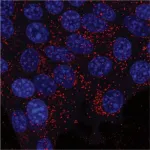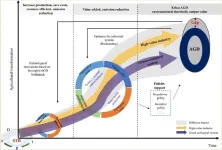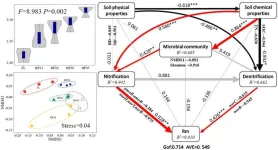(Press-News.org) A Dartmouth-led study suggests that people who frequently consume seafood may face an increased risk of exposure to PFAS, the family of ubiquitous and resilient human-made toxins known as "forever chemicals."
The findings stress the need for more stringent public health guidelines that establish the amount of seafood people can safely consume to limit their exposure to perfluoroalkyl and polyfluoroalkyl substances, the researchers report in the journal Exposure and Health. This need is especially urgent for coastal regions such as New England where a legacy of industry and PFAS pollution bumps up against a cultural predilection for fish, the authors write.
"Our recommendation isn't to not eat seafood—seafood is a great source of lean protein and omega fatty acids. But it also is a potentially underestimated source of PFAS exposure in humans," said Megan Romano, the study's corresponding author and an associate professor of epidemiology at Dartmouth's Geisel School of Medicine.
"Understanding this risk-benefit trade-off for seafood consumption is important for people making decisions about diet, especially for vulnerable populations such as pregnant people and children," Romano said.
The study paired an analysis of PFAS concentrations in fresh seafood with a statewide survey of eating habits in New Hampshire. National data indicate that New Hampshire—along with all of New England— is among the country's top consumers of seafood, which made the state ideal for understanding the extent of people's exposure to PFAS through fish and shellfish.
"Most existing research focuses on PFAS levels in freshwater species, which are not what people primarily eat," said Romano, who studies the effects of PFAS and other endocrine-disrupting chemicals in drinking water on New England communities. "We saw that as a knowledge gap in the literature, especially for a New England state where we know people love their seafood."
The study also drew on New Hampshire's extensive data on the sources and effects of PFAS, which are a staple of consumer products such as plastics and nonstick coatings. The molecular stability that makes PFAS versatile also makes them nearly indestructible, leading them to be called forever chemicals.
In humans, PFAS are associated with cancer, fetal abnormalities, high cholesterol, and thyroid, liver, and reproductive disorders. The chemicals have accumulated in soil, water, and wildlife, and studies have shown that nearly all Americans have measurable amounts in their blood.
"PFAS are not limited to manufacturing, fire-fighting foams, or municipal waste streams—they are a decades-long global challenge," said study co-author Jonathan Petali, a toxicologist with the New Hampshire Department of Environmental Services. "New Hampshire was among the first states to identify PFAS in drinking water. We're a data-rich state due to years spent investigating the impacts of PFAS and trying to mitigate exposure."
The researchers measured the levels of 26 varieties of PFAS in samples of the most consumed marine species: cod, haddock, lobster, salmon, scallop, shrimp, and tuna. The seafood studied was purchased fresh from a market in coastal New Hampshire and originated from various regions.
Shrimp and lobster clocked the highest concentrations with averages ranging as high as 1.74 and 3.30 nanograms per gram of flesh, respectively, for certain PFAS compounds, the researchers report. Concentrations of individual PFAS in other fish and seafood measured generally less than one nanogram per gram.
The prevalence of PFAS in the environment makes it difficult to know exactly where and how the chemicals enter the marine food chain, the researchers report. Some shellfish may be especially vulnerable to the buildup of PFAS in their flesh due to feeding and living on the seafloor, as well as their proximity to sources of PFAS that are near the coast. Larger marine species may ingest PFAS by eating smaller species that, like shellfish, are prone to having the compounds accumulate in their systems.
Buttressing the study is a survey of 1,829 New Hampshire residents the researchers conducted to gauge how much seafood Granite Staters eat—and it's a lot.
The survey found that men in New Hampshire eat just over one ounce of seafood per day and women eat just under one ounce. Both are higher than what the National Health and Nutrition Examination Survey found for men and women in the Northeast, and more than 1.5 times the national average for both. Daily intake for New Hampshire children aged 2 to 11 years old was about 0.2 ounces, the highest end of the range for children nationwide.
About 95% of adults the researchers surveyed reported they ate seafood within the past year, and 94% of that group consumed fish or shellfish within the previous month. More than two-thirds of those respondents ate seafood within the past week.
But people in New Hampshire do not eat seafood uniformly. More than half of the people who ate seafood in the week before the survey lived on the state's coast or near the border with Massachusetts. More than 60% of people with a household income below $45,000 per year reported consuming seafood at least once per week, whereas people with higher household incomes reported eating seafood less often.
Of the species the researchers tested for PFAS, shrimp, haddock, and salmon were consumed by more than 70% of the adults who ate seafood once a month or more. Lobster was eaten by just over 54% of these adults. Salmon, canned tuna, shrimp, and haddock were the most commonly consumed species among children.
Federal guidelines for safe seafood consumption exist for mercury and other contaminants, but there are none for PFAS, said Celia Chen, a co-author of the study and a research professor in the Department of Biological Sciences at Dartmouth.
"Top predator species such as tuna and sharks are known to contain high concentrations of mercury, so we can use that knowledge to limit exposure. But it's less clear for PFAS, especially if you start looking at how the different compounds behave in the environment," said Chen, who leads several federally funded projects examining how and where PFAS accumulate in aquatic food webs in New Hampshire and Vermont.
The establishment of safety guidelines would help protect people who are especially susceptible to pollutants, said Kathryn Crawford, the study's first author and an assistant professor of environmental studies at Middlebury College.
"Seafood consumption advisories often provide advice for those individuals that is more conservative than for the rest of the population," said Crawford, who began the project as a postdoctoral researcher in the Romano Lab at Dartmouth. "People who eat a balanced diet with more typical, moderate amounts of seafood should be able to enjoy the health benefits of seafood without excessive risk of PFAS exposure."
The paper, "Patterns of Seafood Consumption Among New Hampshire Residents Suggest Potential Exposure to Per‐ and Polyfluoroalkyl Substances," was published April 12, 2024, in the journal Exposure and Health. The work was supported by grants from the National Institute of Environmental Health Sciences (R21 ES032187 and R21 ES032187-S1) and the National Institute of General Medical Sciences (P20GM104416).
###
END
PFAS exposure from high seafood diets may be underestimated
Study stresses the need to set safety standards for "forever chemicals" in seafood
2024-04-12
ELSE PRESS RELEASES FROM THIS DATE:
Can TA-NRP increase the number of patients receiving lung transplants?
2024-04-12
Embargoed until 8:30 a.m. Friday, 12 April, 2024 Central European Summer Time or GMT +2
12 April, 2024, Prague, Czech Republic—Re-perfusing the lungs of an organ donor after the heart has irreversibly stopped beating with a technique called normothermic regional perfusion (TA-NRP) could potentially increase the number of patients receiving lung transplants, according to researchers at the Annual Meeting and Scientific Sessions of the International Society for Heart and Lung Transplantation (ISHLT) in Prague.
TA-NRP uses a machine to pass blood through a donor’s abdomen and chest after the heart has irreversibly stopped beating (called ...
Retention ponds can deliver a substantial reduction in tire particle pollution, study suggests
2024-04-12
Retention ponds and wetlands constructed as part of major road schemes can reduce the quantities of tyre particles entering the aquatic environment by an average of 75%, new research has shown.
The study analysed samples collected alongside some of the busiest routes in South West England and the Midlands, many used by more than 100,000 vehicles each day.
Tyre particles were discovered in each of the 70 samples taken, confirming the findings of previous research which has shown them to pose a considerable ...
Softer tumours fuel more aggressive spread of triple-negative breast cancer
2024-04-12
Softer tumours fuel more aggressive spread of triple-negative breast cancer
Researchers have discovered how the mechanical properties of tumours can prime cancer cells to better survive their spread to other organs.
A metabolic ‘survival switch’ controlled by the stiffness of triple-negative breast tumours can significantly influence how successfully their cancerous cells spread to other organs, according to new findings from the Garvan Institute of Medical Research.
The study in cell and ...
Dynamic-EC: An efficient dynamic erasure coding method for permissioned blockchain systems
2024-04-12
It's interesting to hear about the research led by Minyi Guo that was published in Frontiers of Computer Science on 12 Mar 2024. It seems like they are addressing the challenge of reducing storage overhead in blockchain systems while maintaining data consistency and tolerating malicious nodes.
In traditional blockchain networks, full replication is used, where each node stores a complete copy of all blocks, and data consistency is maintained through a consensus protocol. However, this approach can be storage-intensive, especially as the blockchain grows over time.
To address ...
How does the STB promote the coordination between environmental protection and agricultural development in Erhai Lake?
2024-04-12
Erhai Lake, covering 252 km2, located in Yunnan Province, is one of the seven largest freshwater lakes in China. However, over the last three decades, the lake has suffered pollution episodes. In order to solve this problem, the local government has taken many protective measures. These measures have achieved some results in the environmental protection of Erhai Lake, but also caused significant socioeconomic impact. The tension between environmental preservation and economic stability in Erhai has even been termed the ‘Erhai dilemma’. The ‘Erhai dilemma’ is representative of those of other lakes in Yunnan Province ...
New study uncovers the role of soil microbes in forest ecosystems
2024-04-12
Assessing the function of forest ecosystems requires a deep understanding of the mechanisms of soil nitrogen mineralization. A recent study conducted by a team of researchers has shed light on how soil N-cycling genes drive soil nitrogen mineralization during afforestation. The findings, published in the prestigious journal Soil Ecology Letters, provide valuable insights into the relationship between soil microbial communities, functional genes, and the rate of soil nitrogen mineralization.
The researchers collected soil samples from a chronosequence of Robinia pseudoacacia L (RP14, RP20, RP30, and RP45) at different stages of afforestation, along with a sloped farmland (FL) as ...
Cells putting on a face
2024-04-12
Kyoto, Japan -- Mother Nature is an artist, but her craft of creating animal faces requires more than a paintbrush and palette. Such highly complex shapes originate from their respective transient neural crest cells.
These embryonic pluripotent cells within the facial primordium—the early development form—may be necessary for forming proper facial structures. However, analyzing the molecular mechanisms in such early stages of development poses many technical challenges.
Now, a group of Kyoto University researchers have produced neural crest cell-rich ...
First clinical trial of vosoritide for children with hypochondroplasia shows increased growth
2024-04-12
WASHINGTON (April 11, 2024) – Vosoritide’s first global phase 2 study showed an average increased growth rate of 1.8 cm per year in children with hypochondroplasia, a genetic cause of short stature in children, according to researchers from Children’s National Hospital.
“This is the first medicine that has been developed to specifically target the pathway involved in hypochondroplasia,” says Andrew Dauber, M.D., chief of Endocrinology at Children’s National. “These findings will help inform future studies of vosoritide for addressing growth disorders.”
This clinical trial ...
Two key brain systems are central to psychosis, Stanford Medicine-led study finds
2024-04-12
Inside the brains of people with psychosis, two key systems are malfunctioning: a "filter" that directs attention toward important external events and internal thoughts, and a "predictor" composed of pathways that anticipate rewards.
Dysfunction of these systems makes it difficult to know what’s real, manifesting as hallucinations and delusions.
The findings come from a Stanford Medicine-led study, publishing April 11 in Molecular Psychiatry, that used brain scan data from children, teens and young adults with psychosis. The results confirm ...
Rice’s Megan Reiter wins NSF CAREER Award to investigate planet-forming environments
2024-04-12
Megan Reiter, an assistant professor of physics and astronomy at Rice University, has won a National Science Foundation (NSF) CAREER Award to investigate the influence of neighboring stars on the formation of planets.
The research funded by Reiter’s five-year, $951,446 NSF grant will shed light on a phenomenon that could significantly impact our understanding of how planets are born.
“By exploring the intricate interplay between stars, planets and their environments, we hope to clarify the key forces that shape planet formation,” Reiter said.
Observations show planets form in the ...
LAST 30 PRESS RELEASES:
Researchers identify gene that calms the mind and improves attention in mice
Artificial metabolism turns waste CO2 into useful chemicals
Ancient sea anemone sheds light on animal cell type evolution
Begging gene leads to drone food
How climate policies that incentivize and penalize can drive the clean energy transition
Can community awareness campaigns in low-resource areas improve early diagnosis of colorectal cancer?
Stardust study resets how life’s atoms spread through space
Practical education: Clinical scenario-based program development
The impact of family dynamics on eating behaviour – how going home for Christmas can change how you eat
Tracing the quick synthesis of an industrially important catalyst
New software sheds light on cancer’s hidden genetic networks
UT Health San Antonio awarded $3 million in CPRIT grants to bolster cancer research and prevention efforts in South Texas
Third symposium spotlights global challenge of new contaminants in China’s fight against pollution
From straw to soil harmony: International team reveals how biochar supercharges carbon-smart farming
Myeloma: How AI is redrawing the map of cancer care
Manhattan E. Charurat, Ph.D., MHS invested as the Homer and Martha Gudelsky Distinguished Professor in Medicine at the University of Maryland School of Medicine
Insilico Medicine’s Pharma.AI Q4 Winter Launch Recap: Revolutionizing drug discovery with cutting-edge AI innovations, accelerating the path to pharmaceutical superintelligence
Nanoplastics have diet-dependent impacts on digestive system health
Brain neuron death occurs throughout life and increases with age, a natural human protein drug may halt neuron death in Alzheimer’s disease
SPIE and CLP announce the recipients of the 2025 Advanced Photonics Young Innovator Award
Lessons from the Caldor Fire’s Christmas Valley ‘Miracle’
Ant societies rose by trading individual protection for collective power
Research reveals how ancient viral DNA shapes early embryonic development
A molecular gatekeeper that controls protein synthesis
New ‘cloaking device’ concept to shield sensitive tech from magnetic fields
Researchers show impact of mountain building and climate change on alpine biodiversity
Study models the transition from Neanderthals to modern humans in Europe
University of Phoenix College of Doctoral Studies releases white paper on AI-driven skilling to reduce burnout and restore worker autonomy
AIs fail at the game of visual “telephone”
The levers for a sustainable food system
[Press-News.org] PFAS exposure from high seafood diets may be underestimatedStudy stresses the need to set safety standards for "forever chemicals" in seafood





